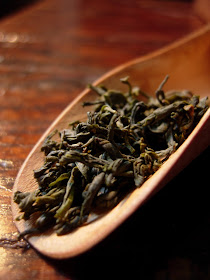So how appropriate that one try this green tea sample sent generously by Chris.
The staples are pulled out of the sealed bag and the dry leaf is scooped into the plain bamboo scoop. The sae jak (maybe even jung jak) sized leaves of deep green smell of salty seaweed, evergreen tree, and figs- not that roasty.
These leaves are placed into a pot when the boiling water has cooled considerably wet embraces dry. Then the liquid is poured into the lovely tea cup that Chris made and sent with the samples.
The first infusion is very light, a little sweet and creamy with slight roasted rice back notes. A nice silky mouthfeel reaches down the throat in the first few sips.

The second infusion the water is a touch warmer, infused for a touch longer. This infusion is more salty, seaweed, and evergreen tree. A sweetness sneaks in briefly under bitter notes. The mouthfeel is most noticeable on the lips and on the tip of the tongue but stretches deep down the throat with grace. It finishes with a dry roasted taste and feel.
The third infusion even warmer water is used for slightly longer. Sweet, dry, lime notes fade into a light wave of dry bitter. The sweetness resumes in the breath. The mouthfeel of this tea is its high point and stays with one for long after the tea is swallowed. The qi on the other hand is not that noticeable. It is gentle on the stomach, rising softly, and bringing a bit of concentration and mental freshness.

The fourth infusion is also a bit hotter than last, a bit longer than last. This infusion has a graininess to it. More evergreen notes are also present especially in the aftertaste. The tastes of this tea are mild, this tea is not an overly flavourful or sweet tea but it feels complete in what it has. The mouthfeel remains stable.
This tea continues to be enjoyed throughout the fifth, sixth, and seventh infusions. Each with hotter water and steeping times that double each other with the resulting infusion. The mouthfeel drops off infusion to infusion from this point. Graininess and wood now dominate with distinct lime notes. But with each infusion even these flavours fade away leaving dry lime with chalky, grainy, bitter notes. To be expected this late in the session.
Thanks again Chris for the experience of sharing this leaf in your cup.
Peace



What I really like on Korean green tea (besides taste and smell) is its ability to create serenity inside me. Some of teas, us I drink first than second than third infusions, make me excited, or I wont to dance or sleep or talk a lot or... but Korean green is kind of tea which after each infusion make me more peaceful...
ReplyDeletePetr,
ReplyDeleteThere may be many reasons why Korean greens seem more relaxing and soothing. Most of this is probably due to production- labour intensive production of whole, unbroken leaves, and long hand firing over the iron caldron produce an affect that seems to give Korean teas some sort of tranquility to them.
Really first and foremost the mindset you brew the leaves is always the determining factor in creating peace at the tea table.
Thanks once again on your perspective.
Peace
I live here for 2 years and maybe more ^ ^ and i really love Korean Greentae matcha :) I am planning to go to Boseong someday in Spring, this march or April. Do you know when I can take a trip to there? in spring when people have crop and collect the leaves the make matcha?
ReplyDeleteVan Tran,
ReplyDeleteBoseong is best known for its loose leaf and bag tea although one has heard of matcha being produced there as well.
If you are planning to go to Boseong you may want to go during the Boseong Green Tea Festival in May 14-19th 2013. See this post:
http://mattchasblog.blogspot.com/2013/02/top-annual-korean-tea-festivals-fairs.html
Peace